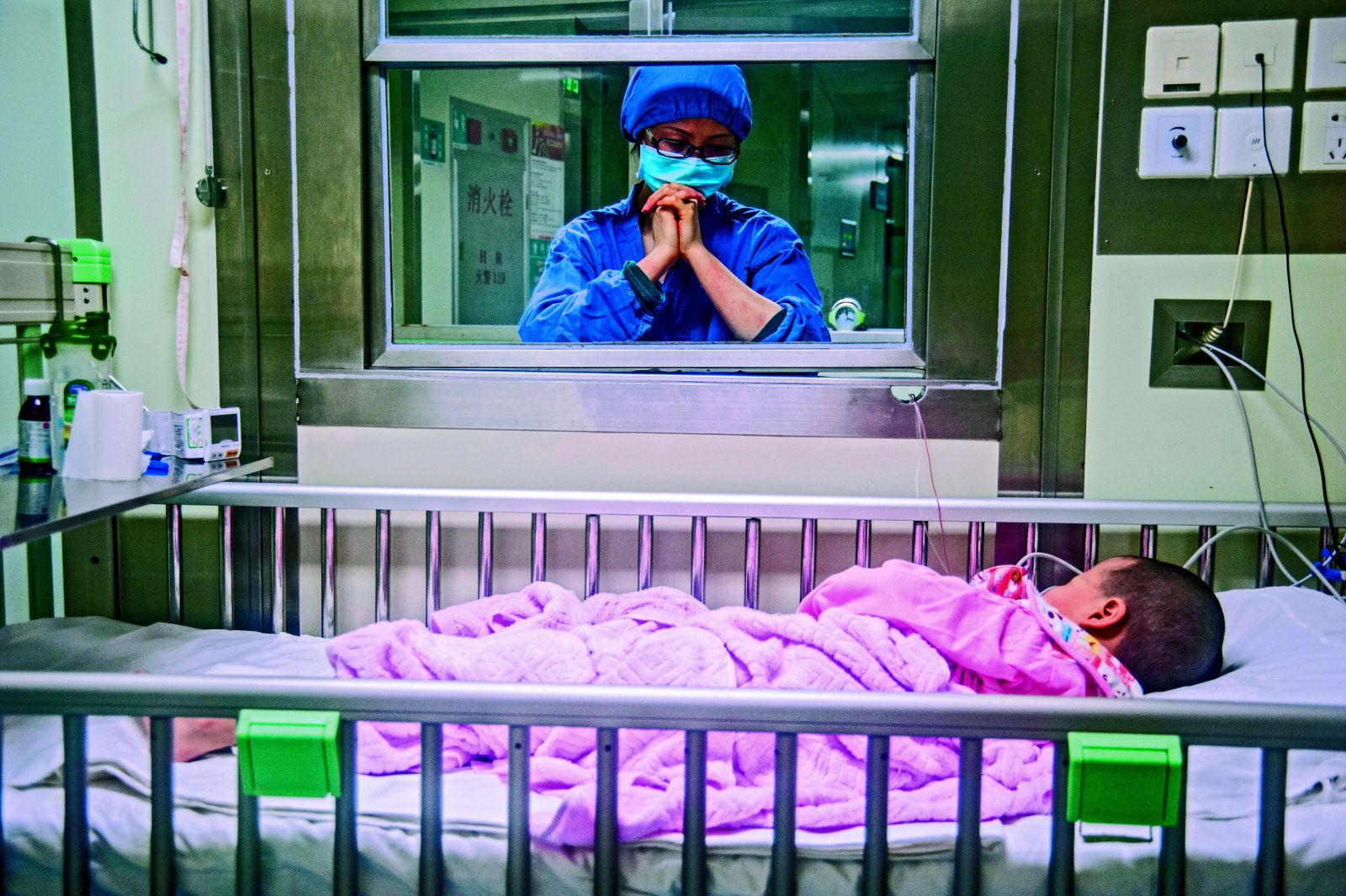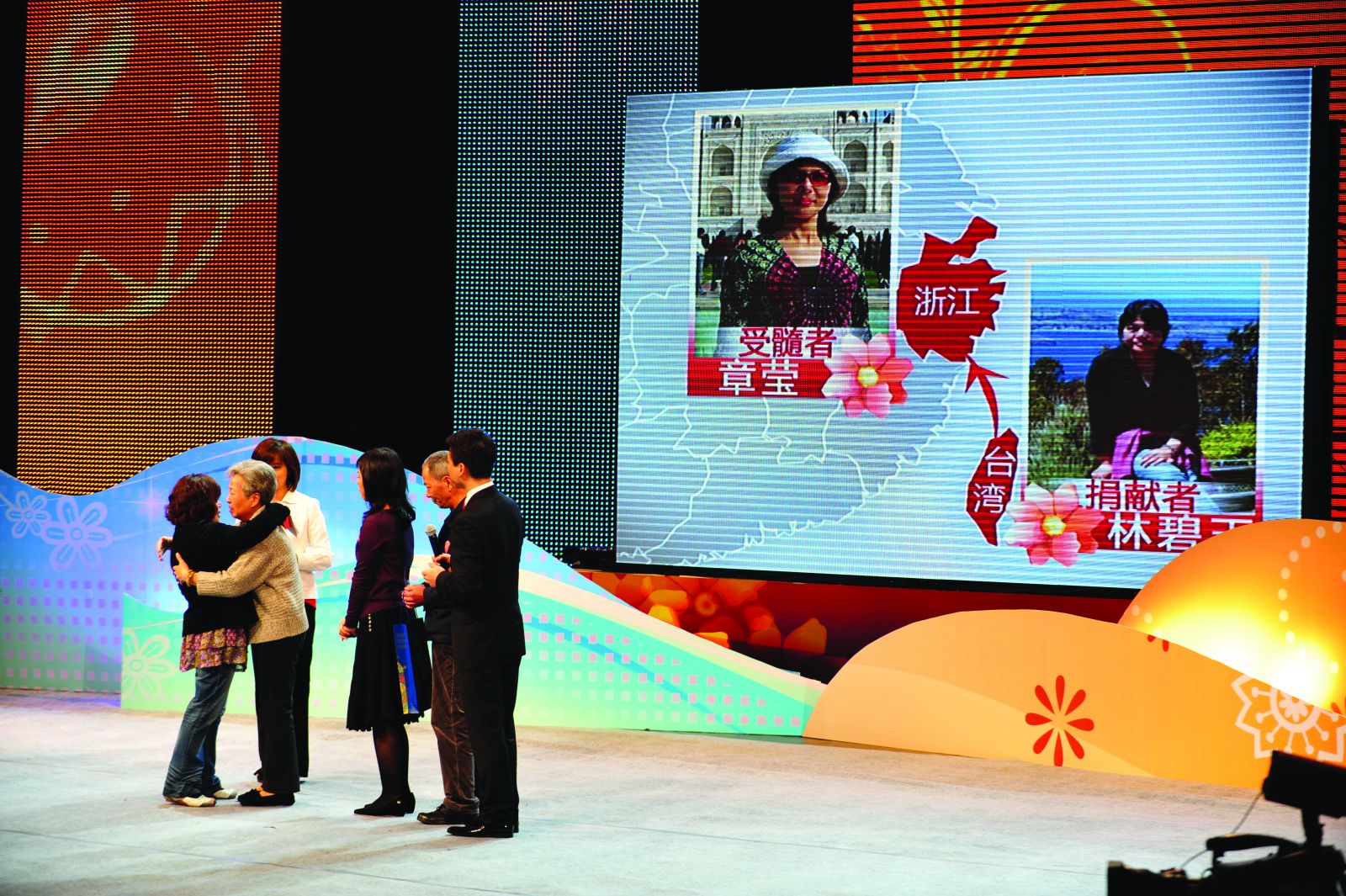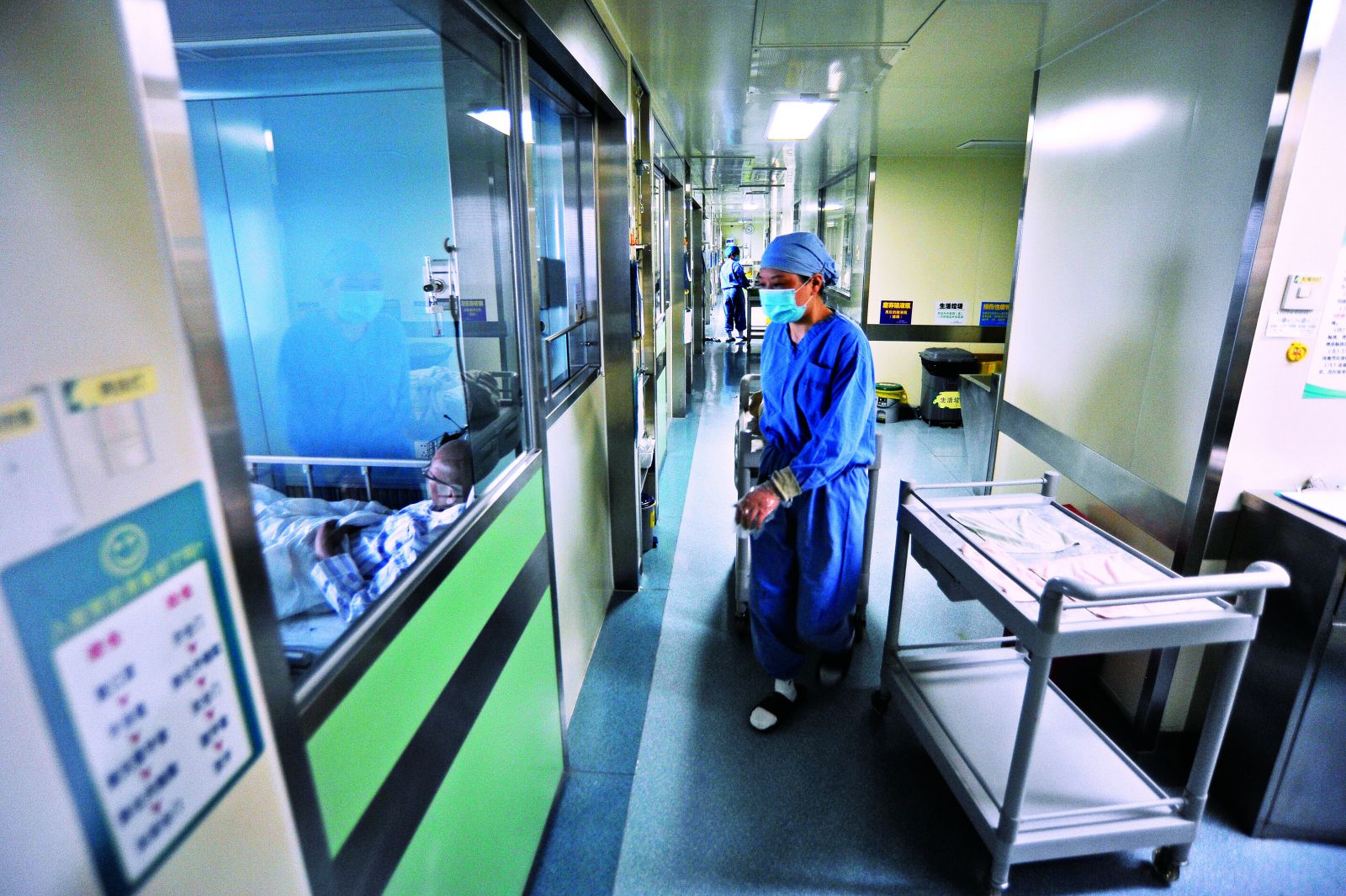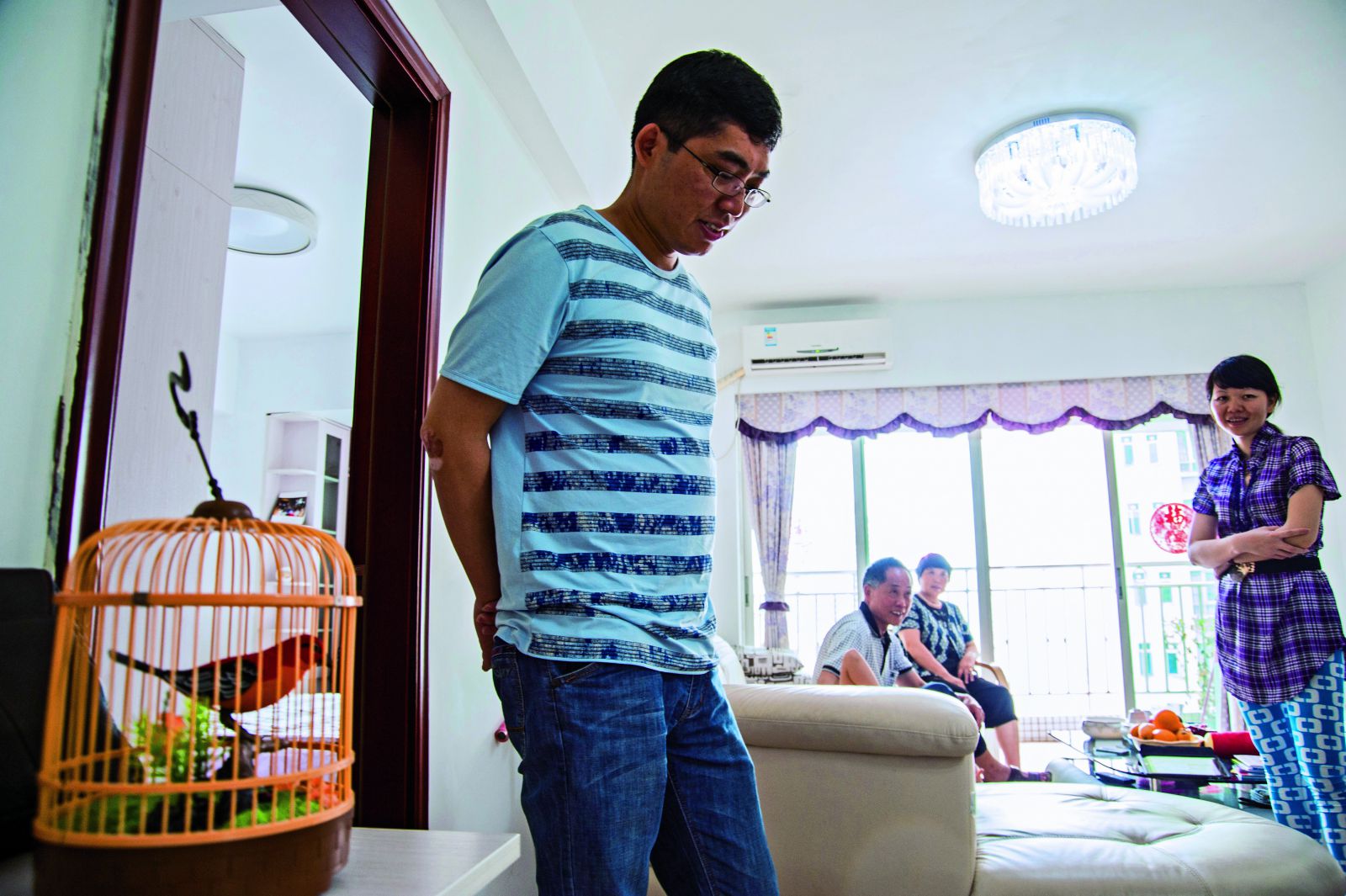

| Blood Ties Between Taiwan and China | ||||||||||||||||
| By Li Wei-huang Translated by Tang Yau-yang Photos by Huang Xiao-zhe | ||||||||||||||||
The first bone marrow donation from Taiwan to China was made through the Tzu Chi Bone Marrow Registry in 1997. A decade later, the first reciprocal transplant from a donor in China to a patient in Taiwan was facilitated by the China Marrow Donor Program. Although relatively new, the China Marrow Donor Program is now the largest marrow registry in the Chinese-speaking world. A similar ethnicity between the citizens of China and Taiwan gives patients on either side better chances of finding compatible donors. In April 1997, against the advice of her family, Yang Xiu-xia (楊秀霞), 54, donated her bone marrow to Liu Jinquan (劉金權), 17, of Anhui Province, China. It was the first such donation ever from a Taiwanese resident to a person in China. In the 16 years since that pioneering gift, almost 1,400 Taiwanese have donated their stem cells to recipients in China. That works out to about 90 cases each year. Not surprisingly, the close ethnic ties between peoples of the two sides increase the chance of a genetic match between potential donors and recipients. Early on that historic April day in 1997, Chen Nai-yu (陳乃裕), executive director of the volunteer team of the Tzu Chi marrow registry, flew from Taipei to the Tzu Chi hospital in Hualien, where he waited for doctors to harvest marrow from Yang Xiu-xia. In a transplant, it is essential that the time lag between harvesting the cells and transplanting them be kept to a minimum so that they may retain their vitality. Therefore, soon after the harvest was completed, the marrow fluid was whisked away in a special container toward its final destination. Chen escorted the container from Hualien to Taipei, Hong Kong, and eventually Beijing. By the time he reached Beijing, it was already past eight o’clock in the evening. He was mindful not to waste any precious time, because the 24 hours between donation and transplant is the maximum window in which the cells are still viable. Even so, some things were out of his control.As Chen went through Chinese customs, the agent, having never before seen such a rare object, examined the marrow container every which way for 40 minutes before letting him pass. “Those were 40 long, torturous minutes,” Chen recalled. His anxiety at racing against a deadline that could not be postponed mounted with each passing moment. Of course, he was not the only one who felt so restless. The hospital staff and especially the patient waiting to receive the marrow were equally anxious.
The marrow express For the ensuing five years, deliveries of bone marrow from Taiwan to China were performed by Tzu Chi volunteers at their own expense. It was not until communications and travel between China and Taiwan became easier and the red tape was simplified that the responsibility for marrow pickup and delivery was handed over to the hospitals in China where the implantations would take place. Though the people escorting the precious packages of marrow have changed, the need for timely and safe delivery has not. The race against the clock continues with each delivery, even today. The people transporting the life-saving packages have more than physical distance to overcome. They also sometimes have to endure and overcome uncontrollable circumstances during the trip, such as flight delays caused by bad weather. Whatever obstacles may lie in wait, they must deliver the goods safely and promptly. People’s lives are in the balance.
Media coverage Tzu Chi has helped provide disaster relief and alleviate poverty for people in China for 22 years. The foundation has been providing stem cell donations for the last 15 of those years. Thanks to positive press coverage, many Chinese citizens are well aware of these donations from Taiwan. The assistance has left deep and lasting impressions in the minds of many Chinese people. One example was a donation that took place in June 2001. The recipient was a blood cancer patient, Chen Xia (陳霞), of Jiangsu Province. The donor was a young man in Taiwan. At the time, the China Marrow Donation Program (CMDP) had only 30,000 donors in its registry, so the chance for a match there was extremely low. On that day, the entire delivery process was broadcast on live TV to people in China. That broadcast, and other similar sorts of press coverage, has helped spread the concept of stem cell donation to many people in that nation. Even Chinese textbooks contain information about stem cell donations through Tzu Chi. In fact, that is why Wei Liwen (魏麗雯), from China, gave her blood for HLA typing to the Tzu Chi Stem Cell Center while studying in Taiwan as an exchange student. She said that she had read about Taiwanese people donating their bone marrow to people in China in one of her junior high school textbooks. Chinese citizens like Wei have become more supportive of stem cell donations in recent years for a couple of reasons. First, knowledge of blood diseases has become more widespread. Second, they have been inspired by loving marrow donors in Taiwan. Over the past decade, multitudes of donors have been added to the CMDP registry, which now boasts 1.67 million registrants. Ten years after the Tzu Chi registry arranged the first donation from Taiwan to China, the CMDP returned the favor. In 2007, the CMPD arranged for Hang Bin (杭彬), a 39-year-old woman from Suzhou, Jiangsu Province, to donate to a 16-year-old girl in Taiwan. The two met for the first time in 2010. The Taiwanese girl buried her head in Hang’s shoulder and held the embrace for a long time. In China as in Taiwan, stem cell registries are more important today than in the past. The one-child policy in China has lowered the likelihood of a match from siblings, whereas a declining birthrate is leading Taiwan toward the same predicament. It is therefore becoming more important for the benefit of patients that the two registries work together to improve the likelihood of matching up those who need stem cells with those willing to donate.
Heavy expenses Thanks to the national health insurance program, patients in Taiwan can receive stem cell transplants fairly inexpensively. The same, however, cannot be said of patients in China. According to a recent report from the Red Cross Society of China, it takes at least two to three years for a leukemia patient to go through a cycle of treatment, at a cost of between 100,000 and 300,000 renminbi (US$16,300 and $48,900). If a stem cell transplant is required, then the figure goes up to between 300,000 and a million renminbi ($48,900 and $163,000). The Red Cross report further pointed out that of every 100 child leukemia patients that need stem cell transplants, only 30 actually receive the treatment. The other 70 fail to get the transplant for a variety of reasons. Sixty-three percent of those do not get treatment because of the high costs. Stories and reports abound in the press and on the Internet about Chinese patients and their families raising funds for such transplants. When a child develops blood cancer, the illness instantly becomes a problem for the entire family. Even middle-class families cannot emerge from the illness financially unscathed. And it is not just the cost of the transplant itself. There are many other financial impacts for the family of a sick child. For example, an illness like this might require that one parent quit work to care for the sick child, and the family might even need to move close to a distant hospital with the expertise and equipment for treatment or a transplant. Thus, they probably would have to incur the additional cost of renting a place to live out of town. It is not uncommon for such a family to deplete their savings and be plunged into poverty and even deep debts. Sometimes the child dies anyway, leaving the family in emotional ruins too. Last year, a 2-year-old girl afflicted with leukemia began receiving treatment at a children’s hospital in Suzhou. Though her parents’ colleagues had donated money to help the little girl undergo treatment, the money was not enough. The helpless parents could only ask for assistance from the local Tzu Chi office, which was not far from the hospital. Tzu Chi volunteer Li Xin-yu (李芯瑜) said that they are seeing more cases like this one and that they do their best to offer care and financial support to such families.
Love of strangers Aside from the cost, another hurdle that a stem cell seeker in China must overcome before having a transplant is the high rate at which potential donors refuse to donate after a match has been found. According to Hong Junling (洪俊嶺), director of the CMDP, China’s stem cell donor registry is now the fourth largest in the world, after those in the United States, Germany, and Brazil. In 2012 it received about 6,000 requests for HLA matching, through which more than 1,300 suitable donors were found. However, only 652 transplants actually took place. In other words, about half of the registrants identified as matches did not donate for various reasons. Patients’ circumstances might change and make transplants impractical, but more commonly potential donors either change their minds or yield to family objections. “Every time I hear that someone has refused to donate, I’m too sad to eat,” said Hong. He readily acknowledged that the refusal rate was very high. He wanted to emulate Tzu Chi’s approach: to more clearly and thoroughly explain what is involved in the process in hopes that fewer people will change their minds once they are identified as matches. A seven-year-old girl from northeastern China had waited for a match from the CMDP for a long time without luck. One day her desperate parents and family heard heart-rending cries from the patient room next door, where a boy, also seven, had just succumbed to blood cancer. The girl’s father cried for a day in the bathroom. “I couldn’t bring myself to face my child—I was so afraid of losing her,” he said. Later a match was found in the Tzu Chi registry. Many relatives and friends congratulated the girl and her family, but the father was still on pins and needles. He couldn’t help worrying that the donor might get cold feet and back out. The father’s fear of disappointment remained until the transplant was finally about to take place. In tears, he wanted to shout to the world that his little girl finally had a chance to live. He was so thankful to the Taiwanese who was donating to his daughter. After the transplant, the girl stayed in a sterile room for 80 days before she walked out on her own power. As she left the room behind, she threw herself into her father’s waiting arms. “When my healthy daughter stood in front of me, I felt life was so beautiful,” he said. Now that he had his girl back, it didn’t matter to him that he was deep in debt because of her ailment. Zhang Ying (張瑩), who had been raised by her adoptive parents in southern China, began suffering from blood cancer as an adult. It took her a lot of effort to finally locate her blood relatives after her diagnosis. She even found a compatible donor in her own older blood sister. Just as she was elated with a renewed hope of life, her sister refused to donate her stem cells. Zhang’s heart was broken. Fortunately, she found a match in the Tzu Chi registry. A girl in Taiwan donated her marrow, and Zhang’s health bounced back after the transplant. She writes a letter to her donor, her savior, at every Chinese New Year and Mid-Autumn Festival. The two finally met in Suzhou in a gathering of donors and recipients from China, Hong Kong, and Taiwan in October 2010, ten years after the transplant. Hugs and tears abounded on this heart-warming occasion.Earlier, more than 30 recipients and donors in China, including Zhang and Hang Bin, had expressed their appreciation for what Taiwanese people had done to help Chinese blood cancer patients by donating money to help victims of Typhoon Morakot, which severely damaged southern Taiwan in 2009.
More challenges The CMDP, though already the fourth largest registry in the world, has a lot of room to grow yet. More than 300 out of every 10,000 people in the United States have joined that country’s marrow donor registry; that number is 144 in Taiwan, but only 13 in China. The growth potential for the CMDP is tremendous. This also means that many patients are not getting transplants that they desperately need. The CMDP, now with 1.67 million registrants, is growing at a rate of 160,000 new registrants each year, and it is on track to break the two million mark by 2015. However, that respectable number is overwhelmingly dwarfed by the four million blood cancer patients in China, with 40,000 new patients each year. The only way to improve the odds of a match for blood cancer patients in China is to significantly increase the size of the CMDP registry. That size, however, is actually being hindered by another kind of size: the geographic vastness of China. According to a blood oncologist at Guangdong General Hospital, the size of the country has made it necessary to have 31 regional marrow registries, whose data is consolidated by the CMDP into a single national registry. Close to half of the current registrants gave their blood specimens when they were students. Once they graduated, they moved away in all directions, making it exceedingly hard now to locate them when they are identified as HLA matches. As a result, blood cancer patients in China face the prospect of not being able to find stem cell donors. Prior to heading the CMDP, Hong worked for the Red Cross Society of China. He pointed out that in the old days many people sold their blood. That practice made the general public reluctant to support marrow donations, out of fear that their marrow might also be sold for money. “Winning societal support remains the most daunting challenge in advancing the work of voluntary, uncompensated stem cell donations,” Hong said. Yet one more hurdle is the lack of sterile rooms: Even if patients are fortunate enough to find compatible donors, they will be at the end of a long waiting line for sterile rooms, without which a transplant cannot proceed. Immediately before and for some time after a stem cell transplant, the patient has no immunity against illness or infection, and therefore he or she must stay in a sterile room until the implanted stem cells rebuild the immune system. Pediatrician Li Chunfu (李春福) at Southern Hospital in Guangzhou pointed out that his hospital had been building sterile rooms, but they had never been able to build enough of them to satisfy the large patient demand. More donations facilitated by the Tzu Chi Stem Cell Center have gone to this hospital than to any other facility in China.
Li, a preeminent expert in treating thalassemia (a form of anemia), has achieved a 90 percent success rate for stem cell transplants. He said that his department performed more than a hundred transplants in 2012, with Taiwanese donors involved in most of those cases. However, many more patients are still waiting. “More than 300 children with thalassemia have already been matched with donors, but they’re waiting for sterile rooms,” Li explained. “It’s estimated that it’ll take two years for all these patients to receive transplants.” The Sun Yat-sen Memorial Hospital of Sun Yat-sen University, also in Guangzhou, is facing the same quandary. To accommodate patient demand, the hospital is trying to build more sterile rooms. Presently, the hall outside the existing sterile rooms is extremely narrow, not the most accommodating to visitors, but they cannot and do not complain. They know it is more important to use the space for sterile rooms than for visitors’ lounges. Fang Jianpei (方建培), chief of the pediatric department at Sun Yat-sen Hospital, remarked that they had completed 18 stem cell transplants that were facilitated by the Tzu Chi Stem Cell Center. The center, Fang said, was strictly managed and highly efficient, and it was therefore able to provide stem cells of particularly good quality. Sixteen of the 18 recipients have recovered.
● In 2011, Abin, of Guangzhou, received a stem cell transplant at a hospital in Beijing. The transplant took place on his 33rd birthday, a date, he said, on which he was reborn. He heard that his donor was a Taiwanese woman who weighed less than 45 kilograms (99 pounds). Abin is especially grateful to her because she probably had to donate proportionally more than usual to support his 80-kilogram (176-pound) frame. Abin returned home after the transplant, and he now often reads with his youngest daughter, something that he rarely did before he fell ill. He was too busy making money to do that. He recalled how he had despaired after he was diagnosed with acute leukemia and began receiving endless rounds of chemotherapy. It was not until he found a stem cell donor in Taiwan that his faith in life was reignited. Now he often cheers up other patients by way of social media on the Internet. One day a woman posted a message to Abin to say that her husband had passed away while waiting for a suitable donor. Abin could not find anything consoling to say to the woman. He knew how terrible she must be feeling, having himself been through the trials of the illness. He knows that only by mobilizing more of his fellow Chinese to join the stem cell registry of the China Marrow Donation Program will more blood cancer patients become fortunate recipients like himself.
|














|








